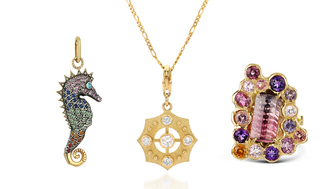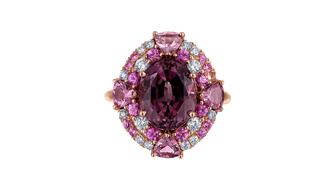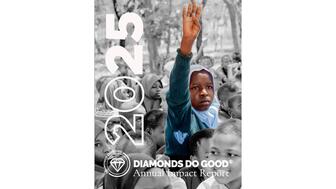As the shopping mall model evolves and online retail grows, Smith shares his predictions for the future of physical stores.
US Gold Jewelry Demand Down Slightly in Q3
The market saw demand decrease 1 percent, its first decline in three years, due to uncertainty from the presidential election and reluctance to spend amid the global economy.

London--The U.S.’s three-year streak of increasing gold jewelry demand came to an end in the third quarter, according to the World Gold Council’s latest Gold Demand Trends report.
The United States saw gold jewelry demand decrease by 1 percent year-over-year in the third quarter 2016 to 26.2 tons, marking the first decline in three years.
This is notable since the first half of 2016 saw the strongest jewelry demand in seven years as the U.S. continued a slow-but-steady recovery in the wake of the financial crisis.
Year-to-date, consumer demand of 74.6 tons is on a par with last year, the WGC said.
The council said that jewelry imports subsided during the quarter as inventory levels across the supply chain are at healthy levels.
It also noted that the uncertainty surrounding the now-over presidential election was responsible for some of the weakness, but added that research also suggests that wealthy consumers have become more reluctant to spend amid concerns about the global economy.
Globally, gold demand was down 10 percent year-over-year in the three-month period on the high gold price, and gold jewelry specifically saw a 21 percent decrease, marking its biggest decline since Q2 2014. It was the lowest third quarter for jewelry demand since 2011.
Year-to-date, jewelry demand has declined 18 percent compared with the same period last year to 1,423.6 tons to mark the lowest Q1 to Q3 total since 2009.
With a few minor exceptions, the WGC reported a decrease in all its monitored consumer markets, with a 28 percent decline in India and a 22 percent decrease in China, the world’s two largest markets for gold, as well as a 35 percent decrease in the Middle East and 31 percent decline in Europe (year-over-year).
High prices were the cause of continued weakness in the jewelry sector, which has seen a “severely depressed” 2016 so far.
The council said that the fourth quarter should see a recovery, with the drop of the gold price in October and the approach of key buying and gifting seasons, but it doesn’t expect a “clear revival” as pressures remain, Chinese consumers are changing their tastes, consumer environments in Europe and the U.S. remain hesitant, and more.
U.S. Consumer Trends
The first half of 2016 saw the strongest level of jewelry demand in the nation for seven years as the market continued its slow economic recovery.
With that in mind, the WGC surveyed 2,000 females in
The survey found that gold does still play an important role in the U.S. jewelry market, with almost two-thirds of respondents stating that they own gold jewelry and 11 percent indicating they intend to buy gold jewelry within the next 12 months.
It also found that 14-karat gold is dominant in the U.S. market.
Of the consumers who had bought gold jewelry within the past year, 46 percent bought 14 karat while 22 percent purchased 18 karat.
Meanwhile, branding does not seem to play a big role in gold jewelry purchases in the country, with 45 percent of consumers who had bought gold jewelry saying it was unbranded, compared with 29 percent and 35 percent for diamond and platinum jewelry, respectively.
This appears to be a trend in the market, the WGC said, as “multi-line retailers dominate, and have been gaining market share at the expense of specialty jewelry merchants, who have suffered severe sales shrinkage so far this year.”
Even though purchasing via the internet continues to be an important part of the industry, the in-store experience still is a crucial aspect as well: 55 percent of survey-takers saying they sought ideas at stores before making a purchase, followed by opinions and suggestions from friends and family.
For millennials, however, this was a little different--while they still used stores and friends and families, online blogs were the most popular part of deciding about a purchase.
Though the WGC found that the U.S. gold market still isn’t where it was 10 years ago, there appears to be plenty of latent demand in the U.S., where “share of mind” is greater than the actual “share of purchase.”
This latent demand is a positive thing for retailers, even though the WGC noted that it’s not easy to convert that directly to sales, especially as U.S. consumers think it is somewhat unaffordable and fine jewelry underperforms with the younger generations.
They will need to “tackle consumers’ price and affordability perceptions, for example, by continuing to develop and market pieces at lower price points, and by developing online strategies to engage more effectively with the younger generation.”
The Latest

The trade show is slated for Jan. 31-Feb. 2 at The Lighthouse in New York City's Chelsea neighborhood.

January’s birthstone comes in a rainbow of colors, from the traditional red to orange, purple, and green.

How Jewelers of America’s 20 Under 40 are leading to ensure a brighter future for the jewelry industry.

The annual report highlights how it supported communities in areas where natural diamonds are mined, crafted, and sold.


Footage of a fight breaking out in the NYC Diamond District was viewed millions of times on Instagram and Facebook.

The supplier has a curated list of must-have tools for jewelers doing in-house custom work this year.

Roseco’s 704-page catalog showcases new lab-grown diamonds, findings, tools & more—available in print or interactive digital editions.

The Signet Jewelers-owned store, which turned 100 last year, calls its new concept stores “The Edit.”

Linda Coutu is rejoining the precious metals provider as its director of sales.

The governing board welcomed two new members, Claire Scragg and Susan Eisen.

Sparkle with festive diamond jewelry as we celebrate the beginning of 2026.

The master jeweler, Olympian, former senator, and Korean War veteran founded the brand Nighthorse Jewelry.

In its annual report, Pinterest noted an increase in searches for brooches, heirloom jewelry, and ‘80s luxury.

Executive Chairman Richard Baker will take over the role as rumors swirl that a bankruptcy filing is imminent for the troubled retailer.

Mohr had just retired in June after more than two decades as Couture’s retailer liaison.

Shekhar Shah of Real Gems Inc. will serve as president of the Indian Diamond & Colorstone Association in 2026.

This year’s good luck charm features the mythical horse Pegasus, and is our first Piece of the Week of the new year.

Articles about crime, engagement rings, and a necklace worn in the World Series generated the most interest among readers.

As part of the leadership transition, Sherry Smith will take on the role of vice president of coaching strategy and development.

It marks the third time the country has headed the Kimberley Process. Ghana will serve as vice chair.

The new Bulova x Stetson designs highlight two animals often associated with the American West—the bison and the Texas Longhorn.

Its residency at Yamron Jewelers will run through May 2026.

From influential executives to innovative designers, we pay tribute to the people we said goodbye to this year.

The retailer is expanding into areas with large Indian and South Asian populations.

The Italian brand has opened its first flagship amid the peaks of the Dolomites in Madonna di Campiglio, Italy.

The new curation at the Natural History Museum of Los Angeles County showcases rare gem and mineral specimens in their uncut, natural state.




























